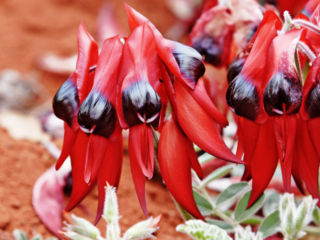
Swainsona formosa, commonly known as Sturt's desert pea or Sturt pea, is a species of flowering plant in the family Fabaceae and is native to all continental states and the Northern Territory of Australia, with the exception of Victoria. It is a prostrate annual or short lived perennial herb with imparipinnate leaves with about 15 elliptic to egg-shaped leaflets with the narrower end towards the base, and racemes of usually red flowers in racemes of 2 to 6.

Swainsona greyana, commonly known as the Darling pea or hairy-Darling pea, is a species of flowering plant in the family Fabaceae and is endemic to south-eastern continental Australia. It is an erect perennial subshrub with imparipinnate leaves with 17 to 21 egg-shaped leaflets, and racemes of 12 to 20 or more white, pink or purple flowers.
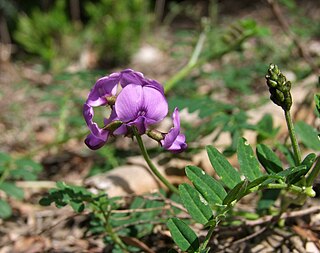
Swainsona lessertiifolia, commonly known as coast swainson-pea, bog pea, Darling peapoison pea or poison vetch is an erect or ascending perennial herb in the pea family and is endemic to south-eastern Australia. It has 13 to 21 narrowly elliptic to elliptic leaflets, and racemes of mostly 12 to 25 usually purplish, rarely white flowers.
Swainsona adenophylla, commonly known as violet swainson-pea or violet Darling pea, is a species of flowering plant in the family Fabaceae and is endemic to arid areas of central Australia. It is a slender, erect or spreading perennial herb with imparipinnate leaves with three to nine linear to narrowly egg-shaped leaflets, and racemes of pink or purplish flowers in racemes of ten to twenty.
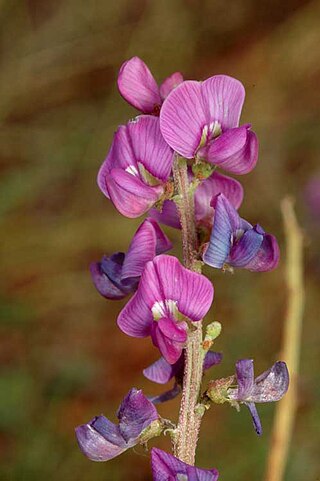
Swainsona affinis, commonly known as common poison pea, is a species of flowering plant in the family Fabaceae and is endemic to arid areas of inland Australia. It is a prostrate perennial herb with imparipinnate leaves with 7 to 25 broadly elliptic leaflets, and racemes of purple, pink, yellow or white flowers.

Swainsona brachycarpa, commonly known as slender swainson-pea, is a species of flowering plant in the family Fabaceae and is endemic to eastern Australia. It is a prostrate or ascending perennial herb with imparipinnate leaves usually with 9 to 13 egg-shaped to narrowly elliptic or egg-shaped leaflets, and racemes of up to 12 white, purple or dark red flowers.
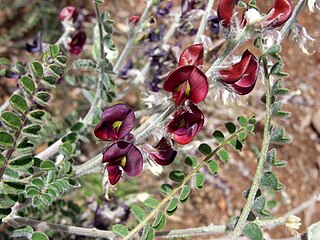
Swainsona burkittii, commonly known as woolly Darling pea, is a species of flowering plant in the family Fabaceae and is endemic to inland Australia. It is an erect or low-lying perennial with imparipinnate leaves usually with 15 to 30 egg-shaped to more or less circular leaflets, and racemes of up to fifty dark reddish-purple flowers.

Swainsona campestris is a species of flowering plant in the family Fabaceae and is endemic to arid areas of southern Australia. It is an erect perennial herb with imparipinnate leaves with 9 to 11 linear to narrowly lance-shaped leaflets, and racemes of pink or purple flowers in racemes of 5 to 10.

Swainsona campylantha, commonly known as Gilgai Darling pea, is a species of flowering plant in the family Fabaceae and is endemic to inland areas of Australia. It is a low-growing perennial with imparipinnate leaves usually with up to 7 narrowly lance-shaped to narrowly elliptic leaflets, and racemes of 2 to 10 pink to purple flowers.
Swainsona eremaea is a species of flowering plant in the family Fabaceae and is endemic to South Australia. It is a low-growing, spreading, probably perennial plant with imparipinnate leaves with 5 to 11 linear, oblong to broadly wedge-shaped leaflets, and racemes of bright red to brown or yellow flowers in racemes of 5 to 20.
Swainsona fissimontana is a species of flowering plant in the family Fabaceae and is endemic to inland areas of southern continental Australia. It is a compact, erect or upright perennial herb with imparipinnate leaves with 7 to 13 narrowly elliptic to elliptic leaflets, and racemes of pink to dark purplish flowers in racemes of 3 to 11.
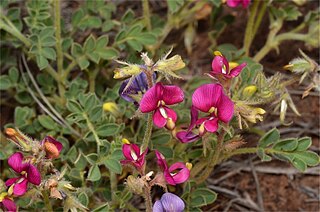
Swainsona flavicarinata is a species of flowering plant in the family Fabaceae and is endemic to inland areas of continental Australia. It is a prostrate to more or less erect perennial herb, with imparipinnate leaves with 5 to 9 egg-shaped leaflets with the narrower end towards the base, and racemes of purple, red or pink flowers in racemes of 3 to 15.
Swainsona forrestii is a species of flowering plant in the family Fabaceae and is endemic to the central northern Western Australia. It is an erect or spreading, single-stemmed annual herb, with imparipinnate leaves with about 13 to 17 narrowly egg-shaped or narrowly ellipitic leaflets, and racemes of dark brownish red to purple or pink flowers in racemes of 30 or more.
Swainsona fraseri is a species of flowering plant in the family Fabaceae and is endemic to eastern Australia. It is a perennial plant with imparipinnate leaves with mostly 21 to 24 ellipitic leaflets, and racemes of 20 or more pink to purple flowers.
Swainsona fuscoviridis is a species of flowering plant in the family Fabaceae and is endemic to South Australia. It is a perennial plant with many stems and imparipinnate leaves with mostly 7 or 9 ellipitic, linear or egg-shaped or lance-shaped leaflets, and racemes of 12 to 20 purple flowers.
Swainsona gracilis is a species of flowering plant in the family Fabaceae and is endemic to the south-west of Western Australia. It is a prostrate or ascending perennial herb with imparipinnate leaves with up to 15 wedge-shaped or narrowly oblong leaflets, and racemes of up to 4 purple or blue flowers.

Swainsona laciniata is a species of flowering plant in the family Fabaceae and is endemic to north-western Australia. It is a prostrate or ascending perennial herb with imparipinnate leaves with 7 to 13 broadly elliptic to broadly egg-shaped leaflets, and racemes of 3 to 8 purple flowers.
Swainsona leeana is a species of flowering plant in the family Fabaceae and is endemic to the south-west of Australia. It is a small prostrate perennial, possible perennial with imparipinnate leaves with 5 to 7 broadly egg-shaped or elliptic leaflets, and racemes of up to 3 purple or yellow flowers.
Swainsona longicarinata is a prostrate or ascending perennial herb in the pea family and is endemic to the far west of Western Australia. It has 5 to 11 variably-shaped leaflets, and racemes of about 7, usually purple flowers.
Swainsona longipilosa is a small annual plant in the family pea and is endemic to a small area in the central west of Western Australia. It has about 5 egg-shaped leaflets with the narrower end toward the base, and racemes of up to 3, reddish purple flowers.











